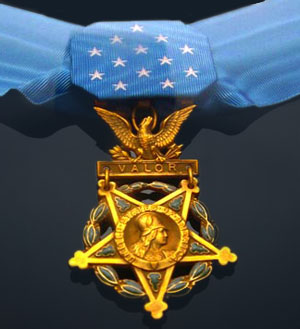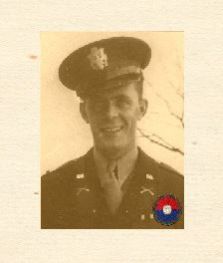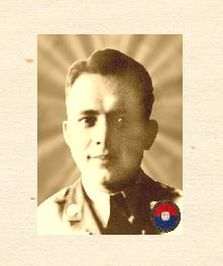The World War II Medal of Honor Recipients of the 9th Infantry Division
The Medal of Honor is the highest award for valor in action against an enemy force which can be bestowed upon an individual serving in the Armed Services of the United States. The medal is generally presented to its recipient by the President of the United States of America in the name of Congress. Because the medal is presented “in the name of Congress,” it is often referred to as the “Congressional Medal of Honor”. However, within United States Code the medal is referred to as the “Medal of Honor”, its official name, and less frequently as “Congressional Medal of Honor”.
For actions above and beyond the call of duty, 5 men of the 9th Infantry Division were awarded the Medal of Honor during World War 2.
World War II Medal of Honor Recipients from the 9th Infantry Division:
2nd Lt. John E. Butts
Company E, 60th Infantry Regiment, 9th Infantry Division.
Date: June 14th, 16th, and 23rd, 1944.
Location: Normandy, France.
General Order Number: 58, 19 July 1945.
Medal of Honor Citation:
Heroically led his platoon against the enemy in Normandy, France, on 14, 16, and 23 June 1944. Although painfully wounded on the 14th near Orglandes and again on the 16th while spearheading an attack to establish a bridgehead across the Douve River, he refused medical aid and remained with his platoon.
A week later, near Flottemanville Hague, he led an assault on a tactically important and stubbornly defended hill studded with tanks, antitank guns, pillboxes, and machine gun emplacements, all protected by concentrated artillery and mortar fire. As the attack was launched, 2nd Lt. Butts, at the head of his platoon, was critically wounded by German machine gun fire. Although weakened by his injuries, he rallied his men and directed 1 squad to make a flanking movement while he alone made a frontal assault to draw the hostile fire upon himself. Once more he was struck, but by grim determination and sheer courage continued to crawl ahead. When within 10 yards of his objective, he was killed by direct fire.
By his superb courage, unflinching valor and inspiring actions, 2nd Lt. Butts enabled his platoon to take a formidable strong point and contributed greatly to the success of his battalion’s mission.
T/Sgt. Peter J. Dalessandro
Company E, 39th Infantry Regiment, 9th Infantry Division.
Date: December 22nd, 1944.
Location: Near Kalterherberg, Germany.
General Order Number: 73, 30 August, 1945.
Medal of Honor Citation:
He was with the 1st Platoon holding an important road junction on high ground near Kalterherberg in Germany on the 22nd of December 1944. In the early morning hours, the enemy, after laying down an intense artillery and mortar barrage, followed through with an all-out attack that threatened to overwhelm the position. T/Sgt. Dalessandro, seeing that his men were becoming disorganized, braved the intense fire to move among them with words of encouragement. Advancing to a fully exposed observation post, he adjusted mortar fire upon the attackers, meanwhile firing upon them with his rifle and encouraging his men in halting and repulsing the attack.
Later in the day the enemy launched a second determined attack. Once again, T/Sgt. Dalessandro, in the face of imminent death, rushed to his forward position and immediately called for mortar fire. After exhausting his rifle ammunition, he crawled 30 yards over exposed ground to secure a light machine gun, returned to his position, and fired upon the enemy at almost pointblank range until the gun jammed. He managed to get the gun to fire 1 more burst, which used up his last round, but with these bullets he killed 4 German soldiers who were on the verge of murdering an aid man and 2 wounded soldiers in a nearby foxhole. When the enemy had almost surrounded him, he remained alone, steadfastly facing almost certain death or capture, hurling grenades and calling for mortar fire closer and closer to his outpost as he covered the withdrawal of his platoon to a second line of defense. As the German hordes swarmed about him, he was last heard calling for a barrage, saying, “OK, mortars, let me have it–right in this position!” The gallantry and intrepidity shown by T/Sgt. Dalessandro against an overwhelming enemy attack saved his company from complete rout.
Sgt. William L. Nelson
60th Infantry Regiment, 9th Infantry Division.
Date: April 24th, 1943.
Location: Djebel Dardys, northwest of Sedjenane, Tunisia.
General Order Number: 85, 17 December 1943.
Medal of Honor Citation:
For conspicuous gallantry and intrepidity at risk of life, above and beyond the call of duty in action involving actual conflict. On the morning of 24 April 1943, Sgt. Nelson led his section of heavy mortars to a forward position where he placed his guns and men. Under intense enemy artillery, mortar, and small-arms fire, he advanced alone to a chosen observation position from which he directed the laying of a concentrated mortar barrage which successfully halted an initial enemy counterattack. Although mortally wounded in the accomplishment of his mission, and with his duty clearly completed, Sgt. Nelson crawled to a still more advanced observation point and continued to direct the fire of his section. Dying of hand grenade wounds and only 50 yards from the enemy, Sgt. Nelson encouraged his section to continue their fire and by doing so they took a heavy toll of enemy lives. The skill which Sgt. Nelson displayed in this engagement, his courage, and self-sacrificing devotion to duty and heroism resulting in the loss of his life, was a priceless inspiration to our Armed Forces and were in keeping with the highest tradition of the U.S. Army.
PFC. Carl V. Sheridan
Company K, 47th Infantry Regiment, 9th Infantry Division.
Date: November 26th, 1944.
Location: Frenzerberg Castle, near Frenz / Weisweiler, Germany.
General Order Number: 43, 30 May 1945.
Medal of Honor Citation:
Attached to the 2nd Battalion of the 47th Infantry on 26 November 1944, for the attack on Frenzerberg Castle, in the vicinity of Weisweiler, Germany, Company K, after an advance of 1,000 yards through a shattering barrage of enemy artillery and mortar fire, had captured 2 buildings in the courtyard of the castle but was left with an effective fighting strength of only 35 men. During the advance, Pfc. Sheridan, acting as a bazooka gunner, had braved the enemy fire to stop and procure the additional rockets carried by his ammunition bearer who was wounded. Upon rejoining his company in the captured buildings, he found it in a furious fight with approximately 70 enemy paratroopers occupying the castle gate house. This was a solidly built stone structure surrounded by a deep water-filled moat 20 feet wide. The only approach to the heavily defended position was across the courtyard and over a drawbridge leading to a barricaded oaken door. Pfc. Sheridan, realizing that his bazooka was the only available weapon with sufficient power to penetrate the heavy oak planking, with complete disregard for his own safety left the protection of the buildings and in the face of heavy and intense small-arms and grenade fire, crossed the courtyard to the drawbridge entrance where he could bring direct fire to bear against the door. Although handicapped by the lack of an assistant, and a constant target for the enemy fire that burst around him, he skillfully and effectively handled his awkward weapon to place two well-aimed rockets into the structure. Observing that the door was only weakened, and realizing that a gap must be made for a successful assault, he loaded his last rocket, took careful aim, and blasted a hole through the heavy planks. Turning to his company he shouted, “Come on, let’s get them!” With his .45 pistol blazing, he charged into the gaping entrance and was killed by the withering fire that met him. The final assault on Frenzerberg Castle was made through the gap which Pfc. Sheridan gave his life to create.
Lt. Col. Matt Urban (then Cpt)
2nd Battalion, 60th Infantry Regiment, 9th Infantry Division.
Date: June 14th to September 3rd, 1944
Location: Renouf, France
General Order Number:
Medal of Honor Citation:
Lieutenant Colonel (then Captain) Matt Urban, l 12-22-2414, United States Army, who distinguished himself by a series of bold, heroic actions, exemplified by singularly outstanding combat leadership, personal bravery, and tenacious devotion to duty, during the period 14 June to 3 September 1944 while assigned to the 2nd Battalion, 60th Infantry Regiment, 9th Infantry Division.
On 14 June, Captain Urban’s company, attacking at Renouf, France, encountered heavy enemy small arms and tank fire. The enemy tanks were unmercifully raking his unit’s positions and inflicting heavy casualties. Captain Urban, realizing that his company was in imminent danger of being decimated, armed himself with a bazooka. He worked his way with an ammo carrier through hedgerows, under a continuing barrage of fire, to a point near the tanks. He brazenly exposed himself to the enemy fire and, firing the bazooka, destroyed both tanks. Responding to Captain Urban’s action, his company moved forward and routed the enemy. Later that same day, still in the attack near Orglandes, Captain Urban was wounded in the leg by direct fire from a 37mm tank-gun. He refused evacuation and continued to lead his company until they moved into defensive positions for the night. At 0500 hours the next day, still in the attack near Orglandes, Captain Urban, though badly wounded, directed his company in another attack. One hour later he was again wounded. Suffering from two wounds, one serious, he was evacuated to England.
In mid-July, while recovering from his wounds, he learned of his unit’s severe losses in the hedgerows of Normandy. Realizing his unit’s need for battle-tested leaders, he voluntarily left the hospital and hitchhiked his way back to his unit hear St. Lo, France. Arriving at the 2nd Battalion Command Post at 1130 hours, 25 July, he found that his unit had jumped-off at 1100 hours in the first attack of Operation Cobra.” Still limping from his leg wound, Captain Urban made his way forward to retake command of his company. He found his company held up by strong enemy opposition. Two supporting tanks had been destroyed and another, intact but with no tank commander or gunner, was not moving. He located a lieutenant in charge of the support tanks and directed a plan of attack to eliminate the enemy strong-point. The lieutenant and a sergeant were immediately killed by the heavy enemy fire when they tried to mount the tank. Captain Urban, though physically hampered by his leg wound and knowing quick action had to be taken, dashed through the scathing fire and mounted the tank. With enemy bullets ricocheting from the tank, Captain Urban ordered the tank forward and, completely exposed to the enemy fire, manned the machine gun and placed devastating fire on the enemy. His action, in the face of enemy fire, galvanized the battalion into action and they attacked and destroyed the enemy position.
On 2 August, Captain Urban was wounded in the chest by shell fragments and, disregarding the recommendation of the Battalion Surgeon, again refused evacuation. On 6 August, Captain Urban became the commander of the 2nd Battalion.
On 15 August, he was again wounded but remained with his unit. On 3 September, the 2nd Battalion was given the mission of establishing a crossing-point on the Meuse River near Heer, Belgium. The enemy planned to stop the advance of the allied Army by concentrating heavy forces at the Meuse. The 2nd Battalion, attacking toward the crossing-point, encountered fierce enemy artillery, small arms and mortar fire which stopped the attack. Captain Urban quickly moved from his command post to the lead position of the battalion. Reorganizing the attacking elements, he personally led a charge toward the enemy’s strong-point. As the charge moved across the open terrain, Captain Urban was seriously wounded in the neck. Although unable to talk above a whisper from the paralyzing neck wound, and in danger of losing his life, he refused to be evacuated until the enemy was routed and his battalion had secured the crossing-point on the Meuse River. Captain Urban’s personal leadership, limitless bravery, and repeated extraordinary exposure to enemy fire served as an inspiration to his entire battalion. His valorous and intrepid actions reflect the utmost credit on him and uphold the noble traditions of the United States.





